Anigrand’s 1/144 Caspian Sea giant
The “Lun” Also Rises...
(about fifteen feet)
by "Bondo" Phil Brandt
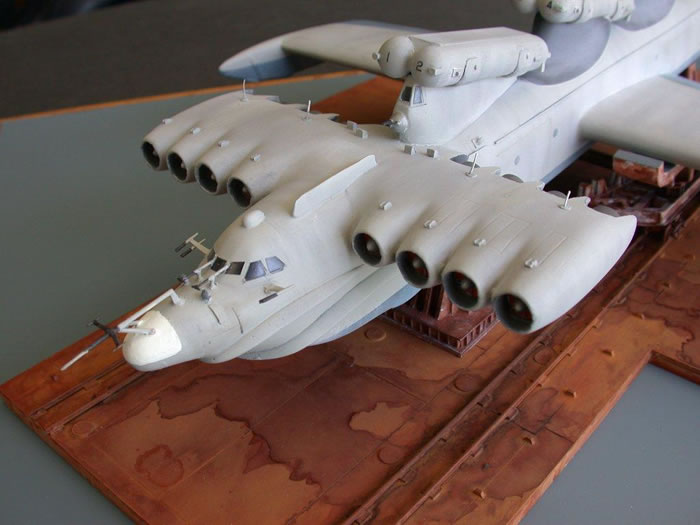 |
“Lun” Ekranoplan |

Special Hobby's 1/48 scale Spitfire Mk.VC is available online from Squadron
Aviation enthusiasts have long been ingrained with the thinking that, post- WWII, the Soviets were willing and often able to copy or reverse engineer practically any Western aviation product extant, imitation being the sincerest form of flattery. Not so the ingenious Ekranoplan species of Soviet ground effect vehicles, airframes so large and heavy that they were actually registered in the Soviet Union as ships...”ships”, that is, that weighed 500 tons and, once airborne, could move in relative ease at fifteen feet above the sea and at approximately 300 MPH!
An Ekranoplan–“ground screen” in Russian–relies on the cushion of air that is generated by an airframe when close to the ground; air that cannot vacate the space underneath the aircraft quickly enough “piles up” underneath to provide lift. Most pilots, especially of large military and civil aircraft, are well-acquainted with the phenomenon, and sometimes must aggressively “drive” said aircraft down through the ground effect to what we in the RF-4C tactical recce force used to call, “a nice, firm, energy-dissipating touchdown.
Although early ground effect experimentation occurred pre-WWII in Germany (Lippisch) and Finland, it was Russian designers that carried the concept to the huge scale circa1965-1987 that existed before the dissolution of the Soviet Union in 1991, the breakup which spelled the end of the Ekranoplan program.

Today, courtesy of marvelously detailed photos taken by a Russian blogger (Igor113), one can view the breathtaking size of the eight-engined “Lun” Ekranoplan–an airframe just slightly smaller (400 tons!) than the famed KM-04 “Caspian Sea Monster” of the Seventies--as it rests on a floating drydock near the Caspian, slowly deteriorating over twenty years. I doubt that it will ever “fly” again.
Weaponry
Two versions of the “Lun” were planned: An attack vehicle (the subject of this article) armed with six large canisters, each holding an SS-N-22 (NATO “Sunburn”) surface-to-surface missile (the first such airframe was built in 1987), and a second, converted to a marine rescue ship, wherein the six missile canisters would be converted to collectively hold, get this, 500 people; never let it be said the Russians think “small.”
The Kit
Hong Kong’s Anigrand has firmly established a reputation for producing a large repertoire of eclectic 1/72 and 1/144 subjects in resin kit form (the latest being the gigantic 1/72 C-5), rare, often experimental, airframes not done by other firms in any medium. Although these kits often leave something to be desired in accuracy and fit, this modeler is more than willing to put up with these idiosyncrasies in light of the “weirdness” factor.
The Anigrand “Lun” kit reveals that this is a REALLY BIG airframe; the 1/144 model is as large as a 1/144 747, easily larger than 1/48 fighters and even some 1/72 four-engine bombers.
Main components were joined (CA, of course) with just a few minor fit problems, most involving the alignment of the halves of each of the two, four-engine turbofan engine nacelles. I’ve complained about this before, but Anigrand could surely ease the efforts of modelers if they’d cast the nose and tailcones of jet engine nacelles as individual, full-circle pieces, such as done by Collect-Aire, saving hours of sanding difficult-to-get-at intake seams, filling, sanding and priming over and over.
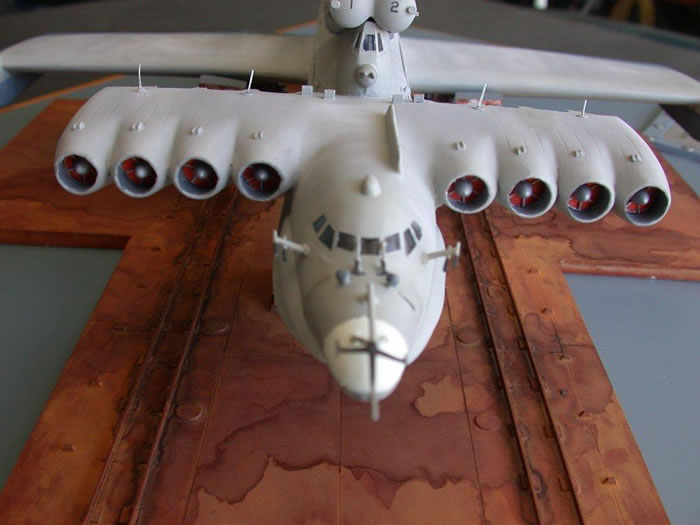
In Anigrand’s defense, they at least did the jet exhaust nozzles in one piece. For color contrast–there’s a lot of gray on this huge airframe--I elected to duplicate the orange FOD covers as shown in Igor’s pix. I cut pie-shaped wedges of thin plastic sheet and simply glued ‘em over the first stage fan blades.
Detailing
If this were a physically small 1/144 airframe, I probably would’ve not felt the need to go out of my way to add additional detailing, but this hummer cries out for remedial action, plus Igor’s great “monster” pix make the details readily viewable..no guessing, as often seems to be the case with Anigrand research.
Weapons
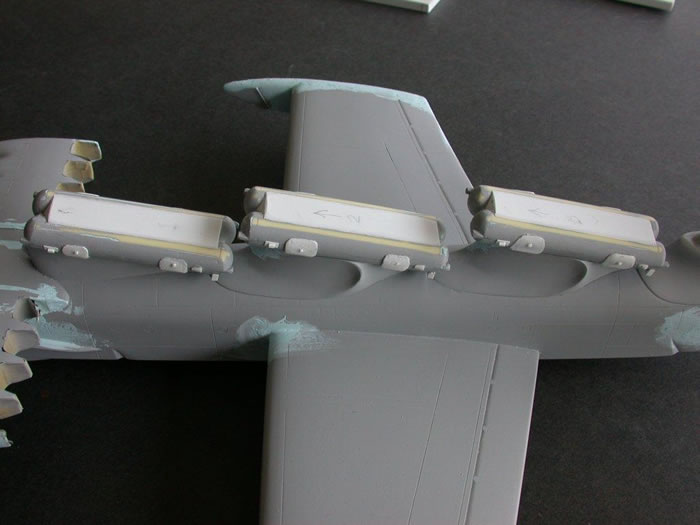
The first upgrade was to the six prominent missile canisters which Anigrand, as in the case of the jet intakes, chose to do in split halves, guaranteeing the drudgery of sanding and filling because of poor fit (further, the one-piece canister end caps didn’t match the diameter of the . Tubes proper...more sanding! ). Plus, Anigrand chose to leave a “Vee”-shaped valley between each mated pair of canisters; Igor’s pix plainly show that the Vee has long been faired in, and the top of each canister pair is flat . Each missile canister has two slightly bulged patches on each side, and unfortunately for the builder, Anigrand chose to make the part split right through said patches. I Dremmeled off the patches and created new, one-piece components by slicing sections of large plastic tube stock. The new sections are perfectly concentric to the existing resin missile tubes and also cover the Dremmeled “scars”. Thin plastic sheet was CA’ed to the tube tops to create the accurate flat surface. Small vents and protruding knobs finished the job.
Fuselage
Igor’s pix reveal a veritable forest of pitots, mirrors, sensors and vents that inhabit the Lun’s nose forward of the cockpit; only a crude representation of the main air probe is furnished by Anigrand, with no further indication of what other apurtenances reside in that area. So, with a bus ticket to Scratchbuild City in hand, this curmudgeon donned his Opti-Visor and added the desired equipment.
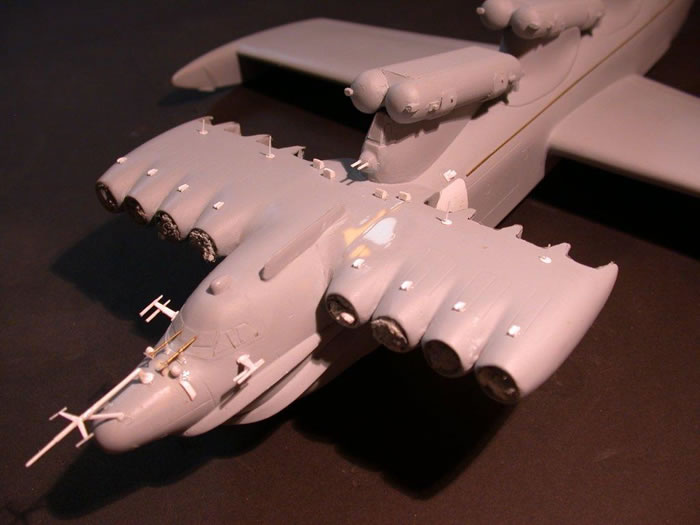
Four aerials. eight engine cowling fixtures and some blocked-off vents were added to the multi-engine nacelle pod, and plastic inner engine exhaust shields were cut out and scabbed onto the fuselage sides. Two pairs of machine guns/cannons were fashioned from small diameter rod and added to the forward and aft defensive turrets. Small spoilers just in front of the aft defensive turret help to “busy” that area; plus, the U-shaped sheet metal “shelf” which curves around the end of the fuselage, just below the rear turret, was non-existent (due to less-than-primo resin casting) and had to be completely scratchbuilt.
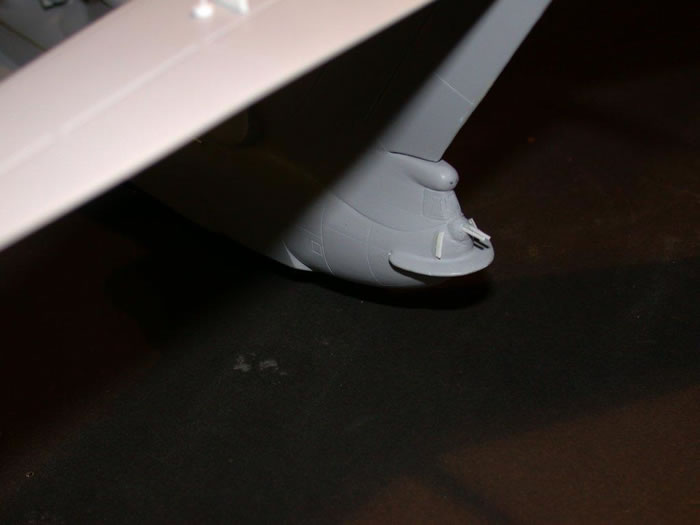
A long piece of very thin brass rod was carefully CA-ed to each side of the upper fuselage. I mistakenly thought that, as is often the case of large Russian aircraft, the rods were some type of control cable housing or some type of radio antenna. The pix notes provided by Igor reveal that there’s a much simpler explanation: the rails are merely anchoring points for maintenance platforms!
Tail
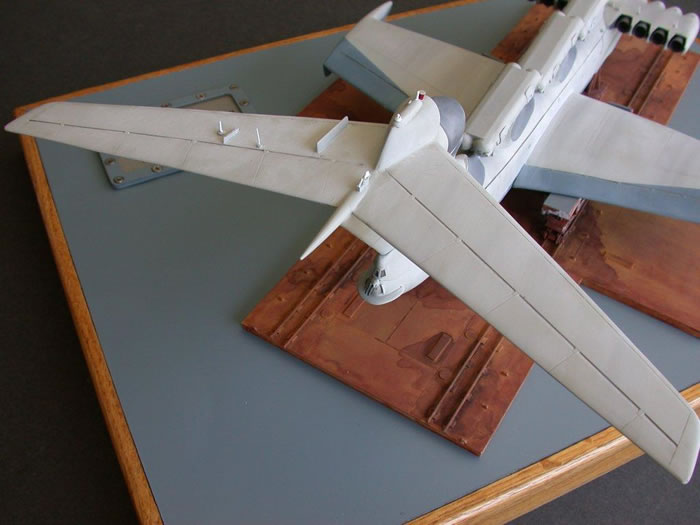
The large, no-dihedral (different from the original KM-04 “Sea Monster” which had a prominent “V“tail) aft flying surface underwent the addition of two finned antennas, one fairly long, and other various rod-type probes and antennas. Once again, Igor to the rescue.
First things first: the required iterations, so common to resin kits, of automotive lacquer primer, followed by that magical 3M Blue Acryl (to fill some misfit areas of approximately 1/32"! ) and lotsa wet sanding.
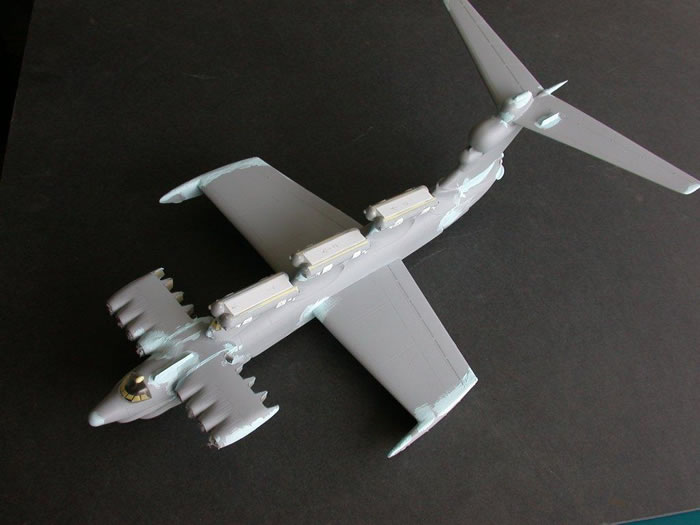
After some ten years of sitting forlornly in the paint rack, I thought the time was long overdue to open various jars of Gunze Sanyo “Aqueous Hobby Color”, which, well-thinned, provided the base light gray airframe color. Intermediate Blue Testors Acrylic, although it’s really a bit too dark–I made it lighter and more vivid later with pastel chalks--was selected for the below-the-waterline and underwing, areas in which Anigrand doesn’t do the best job to make clear color delineations, especially for the underwing and sponsons. Masking over such a complex surface was trying, but it all worked out...until the Testors blue had dried, and then I was belatedly reminded of a note-to-self I hadn’t remembered after painting my 1/32 Echelon F.6 Lightning over ten years ago, “Don’t use Gunze again!” It seems that Gunze has a slight aversion to being covered by non-Gunze water-based acrylics. Tiny cracks (“alligatoring”) appeared in some areas, fortunately areas not easily viewed. I’m just gonna live with it; I’m not really interested, after laboriously weathering the sucker, in sanding and re-shooting the Testors.
The current day Lun airframe has, as you might surmise, weathered badly in the maritime environment of the Caspian. It’s significantly chalked and shows the remains of secondary paint jobs (perhaps just for display) that have been applied over the years. I chose to portray it as it might have appeared when first mothballed after the dissolution of the Soviet Union in 1991–note that there’s no red star on the vertical fin (Anigrand shows one) ...just the naval flag symbol. That is, I have shown the airframe slightly weathered from its test flights and operational mission over a four-year “career”. I shaved pastel blue, white, gray and black powder from my wife’s considerable chalk collection--she’s a pastel/watercolor artist–and scrubbed it (with a ½" short-bristled watercolor brush) in streaks to simulate water runoff patterns, inflight airflow and UV action.
Presentation
In my opinion Anigrand should have at least furnished a rudimentary display stand for such a large (and expensive) model, let alone a beaching trolley (as did Mach 2 in their Seamaster kit), but noooooo. Igor’s pix plainly show the results of two decades’ neglect in a harsh maritime environment, but the color of the badly rusting drydock, beaching trolley and support stands creates, in this elderly mind at least, a welcome contrast with seeming acres of chalky gray airframe. Back to Scratchbuild City.....
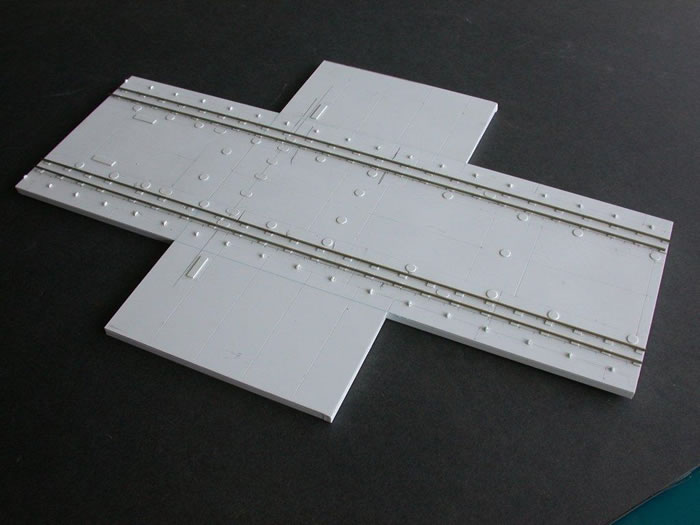
The floating drydock’s perimeter and inner bracing were fashioned with solid, square plastic stock and covered with .060" plastic sheet. Various panels were glued to the flat sheet to add more contrast (they’re in the real deal, too) and the trolley rails were hand-laid (CA-ed) with N-scale model RR stock.
The trolley was built from Igor’s detailed photos, and N-scale RR trucks provided what I think is a fairly adequate representation of the one-off trucks on the real deal.
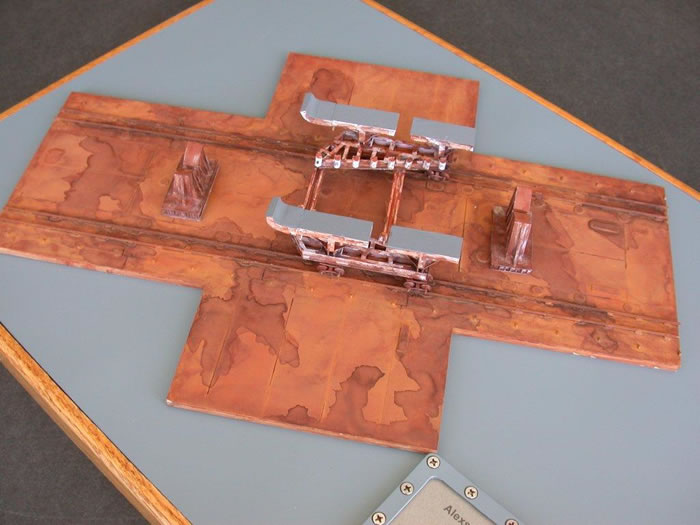
The hefty forward and aft support stands were built directly from close-up pix.
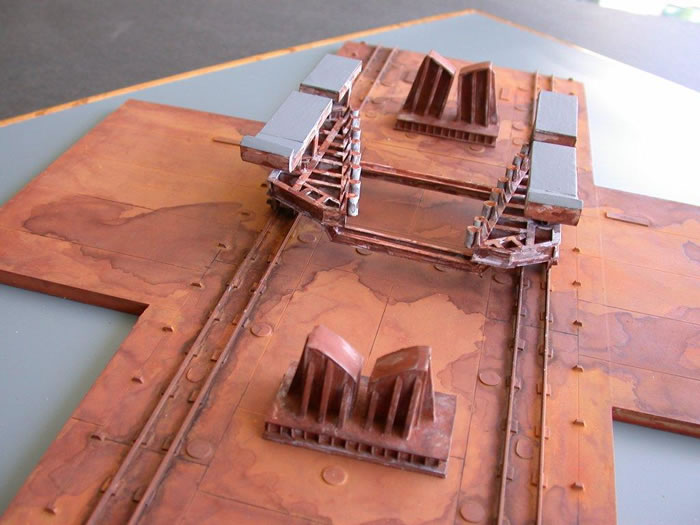
As shown vividly in Igor’s photos, it would be difficult to excessively rust and weather the above support pieces, and the “Rustall” (www.rustall.com) four-component system did a nice job, especially in imitating the dark, stained areas of the drydock where water puddles form. Additionally, two shades of rust powder by Weather System (Bragdon Enterprises, Georgetown, CA) were scrubbed on with a stiff brush. Apparently, this rust powder actually changes over a period of a half-hour into a coating which clings to the surface much more than one would expect powder to do by itself. Good stuff!
So another strange project slides down the slipways of Bondo Industries’ Weirdness Works Division; when and if you see me do a 109, yinz’ll know (a little Pittsburgh-ese for ya) this curmudgeon’s in his personal End Days! Things are gonna get real interesting if Bondo enters the Lun in a SHIP category......
Model, Images and Text Copyright ©
2011 by by "Bondo" Phil Brandt
Page Created 7 June, 2011
Last Updated
8 June, 2011
Back to
HyperScale Main Page

|
Home
| What's New | Features | Gallery | Reviews | Reference | Resource Guides | Forum |